by Jenny Rose | Jul 13, 2017 | A Flourishing Woman, Spirit
I first began thinking about bones 25 years ago when I was given a copy of Clarissa PInkola Estes’s book, Women Who Run With the Wolves. She writes about discovering stories of bone people in the Southwest. Bone people are old ones who collect bones in a desert between the worlds and bring dead animals and humans back to life.
Reanimation is a common creative and spiritual theme. Bones are like seeds; they are the remnants of life, and thus the base material from which to build new life. Bones are the simple starting point, the hidden scaffold and substance that survives.
Several times in my life I’ve found myself walking in a trackless emotional desert, alone, lost, frightened and injured. Old stories tell us during these times we must seek and gather our discarded, stolen and lost bones in order to call ourselves home.
Bones can be hard to see under layers of clothing, flesh, distraction and scar tissue. Perhaps that’s why it was the desert dwellers who kept bone people stories alive. The desert is clean and uncluttered, and the vast sky and sweep of land hold space for stillness and inward journeying.
Bone collecting is like treasure hunting. The first time I went bone collecting, I traveled backwards and excavated memories of my child self. I compared those memories to my adult life and began to sift for my bones, those indestructible pieces of self that have always been present, come what may, sustaining and shaping me from the beginning.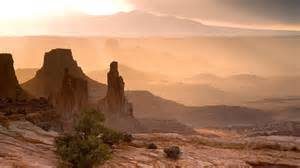
I discovered I’d thrown a lot of bones away over the years. Some I rejected because I judged them as ugly or misshapen. I refused to claim them. Others I grieved to discard, but I believed they were useless, unworthy and/or unlovable, so I dropped them and walked on without marking the spot where they lay.
The desert between the worlds has become a home to me now. The sands know the scent of the naked sole of my foot and the soaring vultures recognize my figure as I wander below them, insignificant as an ant. I’ve crawled and searched, remembered and listened for my whispered name when my missing bones feel me draw near. Some are broken and stained, incomplete fragments that no longer tell their entire story about me, but I’ve learned patience and persistence, and I save every shard and splinter. I’ve traveled miles in the desert to reclaim all those bones, groping my way through old memories, feelings and bits of conversation, sifting my bones from the garbage dump of words that did not belong to me, expectations, rules, beliefs and storm debris from storms that swept me up, though they were not mine.
Over and over, I’ve felt I’ve come to the end of everything, only to find a whole new horizon just a few steps away, at the top of a hill I didn’t know I was climbing. Each time that happens, I pause and inventory my bones. Bone collection has become an external practice as well as an internal one. I’m less and less interested in obscuring the essentials in my life with distraction, objects and complications.
This summer I have a new dimension of perception in discerning the bones of each day, each week and each season. Living simply as we do, having time to stretch out mentally, spiritually and creatively, I’m experiencing for the first time the joy of casting myself into a day with no list, no agenda, no expectations and lively curiosity.
This is, for me, a summer of wood. We’re clearing a knoll of land in order to build a cabin, thinning a grove of spindly alders and cutting an occasional small tree growing in the field which is our building site. As each tree falls, I haul it into the wall of forest surrounding the clearing. In the sunny field, the growth is waist-high, and as I drag trees through it, the sweet scent of milkweed mingles with the smell of fresh-cut wood. Wild cucumber catches at my feet, invisible in the thick growth, and I fall, and fall again, getting up hastily because, although my clothing is doused in bug repellent, rolling on the ground is a foolish exposure to ticks, not to mention rampant poison ivy.
In Maine in the summer, this kind of work is done in light-colored pants and long sleeves to protect from black flies, mosquitoes, poison ivy, nettles and the inevitable ticks. Five minutes of exertion leaves me sweating heavily under the necessary layer of clothing, breathless in the heavy, humid air.
Stepping from the field into the forest, the air cools and I’m shaded from the sun. Here, the undergrowth diminishes and mainly consists of huge ferns, but I still slip and fall, as the forest floor is littered with rotting tree debris and liberally scattered with moss-covered boulders and stones. I drag the cut trees in under the canopy so they can gradually rot and feed their living brethren and the rest of the forest system.
In the driveway, we are processing enormous piles of tree debris from trimming two live trees and from a fallen maple. The maples we trimmed provide us with welcome shade as we work. I fork wheelbarrow load after wheelbarrow load of twigs, small branches and dead leaves off the driveway and tip them over a steep hill out of sight below the house. My partner works with a chainsaw, and its snarl, along with the smell of cut wood, becomes one of this summer’s bones.
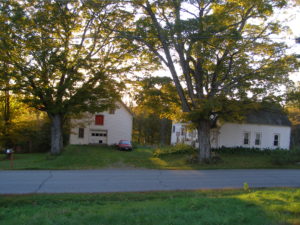
A generous neighbor loaned us his splitter, and once the maple (rock maple, which dulls chainsaws at an alarming rate) is cut into wood stove lengths, we heave the rounds onto the purring splitter, and the smell of the gas engine and sound of the relentless maul cleaving the wood becomes another of summer’s bones.
The healthy wood parts smoothly, revealing ivory, cream, and pinkish-red grain. The diseased wood breaks open, showing honeycombed defects, or crumbling, blackened rot that smells, oddly, like vomit. Heavy, thick bark peels from the wood like scabs as we work. Here in the driveway, I risk working in shorts with bare arms, but the wood is heavy and unwieldy and my legs and arms are bruised and scratched. The way I hold the rake invariably rubs a blister on my left thumb. We sweat through our clothes and I have to keep wiping my forehead and upper lip with my bare forearm and gloved wrist. Hard wood is heavy, especially when still wet, and the inside of my wrist is bruised from supporting two or three pieces as I carry firewood to the wheelbarrow, into the barn or into the cellar for stacking.
Some of this wood has been piled in the driveway for a year. As we work, we uncover an insultingly large woodchuck hole. We find a red salamander, about two inches long. My partner rescues a grass snake from a brush pile and relocates it away from the pitchfork tines. We accidentally lift away a shrew’s roof, and my partner catches the grey velvet covered creature in his gloved hand and releases it over the hill in a safe place. We brush away crickets, earwigs and worms. We split one huge round and little red ants swarm over it, hysterically collecting a broad swathe of exposed white eggs. My gloves are covered with them, and the ones who run fast crawl onto my arms and bite before I can brush them off. We set those pieces of wood aside before splitting them further to give the ants a chance to find a new nursery.
We have birdfeeders along the driveway, and the birds are the backbone of the summer days, stretching from dawn to dusk. As soon as we take a break from work, the woodpeckers gleefully swoop in for uncovered insect tidbits, and the nuthatches scurry up and down the trunks of the standing trees with their fluffy, uncoordinated offspring. The finches and sparrows return to the seed feeders from their observation posts high in the surrounding canopy.
Our resident chipmunk is so curious he can’t stay away, but as we disassemble all his best hidey holes he scolds endlessly, like a shrill and irritated metronome, glaring from under the hostas or the gap in the porch floor.

Nesting Phoebe
birdsandbloomsblog.com
Strangely, the shy phoebes like best to nest in the barn, in spite of my partner frequently playing music and our wood stacking and other noisy activities. They arrow in and out of several broken windows when the barn is shut, but on days when we’re working, they use the same door we do. Because of them, the cool barn is not only a haven of shade, but free of flies and mosquitoes. We know where the nest is, but we’re careful to ignore it and whichever motionless parent is sitting on the eggs when we happen to be present. Even the nestlings are still and silent as stone when we enter. The phoebes are currently raising their second brood, and their first set of offspring darts all over the place, hunting insects and filling the days with their distinctive cry, which gives them their name.
The bones of summer in this place mingle with my own bones. We are a bruise, a scratch, a sticky film of sweat on the skin, a sly mosquito bite. We are birds strung on the lace of trees; the private life of snake, shrew, salamander and woodchuck; the determined persistence of insects. We are tree and water and moss-covered stone. We are the smell of rotten wood, of sweat, of blossom. We are the breeze in the tree, the sound of the phoebe questing for insects, the tapping woodpecker, the hunting hawk’s cry as it circles, and the clamor of the tools we use to work on our land.
The days saunter through the season, leading me forward by the hand, and I follow, stopping every now and then to collect and record the ravishing experience we call life in words, and each word is a miniscule bone, too, each page a scatter of tiny bony seeds that wait for warmth and light, water and the soil of life and death in order to take root, grow, blossom, fruit and die, again … and again … and again.
All content on this site ©2017
Jennifer Rose
except where otherwise noted
by Jenny Rose | Jul 6, 2017 | Connection & Community, Emotional Intelligence
This week I’m exploring the idea of cultural appropriation. In the linked article, cultural appropriation is defined as “Taking intellectual property, traditional knowledge, cultural expressions, or artifacts from someone else’s culture without permission. This can include unauthorized use of another culture’s dance, dress, music, language, folklore, cuisine, traditional medicine, religious symbols, etc.” This definition provides a useful starting point, but it begs a couple of important questions.
I approach cultural appropriation from two different directions. I begin with a story I wrote years ago for oral telling. The story was inspired by the wonderful children’s author and illustrator Eric Carle . He wrote several books, among them Draw Me a Star. As a parent and librarian, I’ve bought, recommended and read aloud his books hundreds of times. You can look at ‘Draw Me a Star’ here .
The Artist
“Sing me a star …”
And the Artist sang a star.
It was a shining star.
“Color me a sun,” said the star.
And the Artist colored a glowing sun, a golden lion, a hillside of orange poppies, a burning fire, and a feather.
It was a red feather.
“Weave me a tree,” said the feather.
And the Artist wove branches and leaves and pieces of sky into a tree, and She wove fields and forests and deep, invisible roots, and a spider’s web.
“Build me a fence,” said the spider.
And the Artist built a fence and sculpted rocks and ice and sand and snow into a world.
It was a glorious world.
“Tell me a story,” said the world.
And the Artist began, “Once upon a time …”
It was a wonderful story.
“Tell me some more!”
So the Artist made all kinds of people to share all kinds of stories.
They were strong people.
The people said, “Teach us what love is.”
And the Artist said,
“Sing me a star …”

Photo by Leon Liu on Unsplash
Now set your burdens down for an hour and dance with me. Here’s the sound track I made for our community dance last Monday evening.
“Symphony of the Forest and Mysterious Island,” by Kitaro a Japanese artist.
“Maryam,” by Hamza Shakkur, from the soundtrack to the movie Bab’ Aziz , a Tunisian foreign film.
“Aye Lon Lon Vadjro,” by Angelique Kidjo , an African artist.
“Kozuma,” by Professor Trance and the Energizers, who perform multicultural Trance Dance music.
“Stars Align,” by Lindsey Stirling, an American violinist.
“Mwari,” from the album World of Rhythm.
“Pinguli Pinguli Giuvaccinu,” by Savina Yannatou , a Greek artist.
“Barcelona Nights” by Ottmar Liebert, a German guitarist.
“Symphony of Dreams and A Drop of Silence” by Kitaro.
I wouldn’t steal a pencil or a nickel. It’s easy to make a distinction between concrete objects belonging to me and those that don’t. Trying to define intellectual and cultural property, however, is another thing. Part of my integrity as a storyteller includes rigorously reporting the origins of my material to my audience. Part of my integrity as a librarian and a researcher includes investigating roots and versions of old stories and communicating that information to my audience so they get a glimpse of the amazing historical journey of human creativity and experience. Part of my integrity as a writer is to be open to the world of human beings around me in all its rich history, language, symbol, tradition, spirituality, expression, art, ideas and feelings.
Anyone who creates art or delves into old oral traditions realizes cultures are not so easy to distinguish from one another, and the farther back we trace certain artifacts, oral material, symbols and traditions, the more blurred the boundaries between cultures become. Part of my motivation in becoming a storyteller is to become a link in a long, long chain of humanity that reanimates old stories. Oral tradition survives because it speaks to the culture of human beings. Themes of love, birth, death, war, change and power engage everyone. The repeating horrors of colonization, genocide, slavery, plague and pestilence, massacre and religious persecution are embedded in the history of every culture on every continent.

Photo by NASA on Unsplash
It would be convenient to simplify the history of mankind into good/bad, victim/oppressor and black/white literally, as well as figuratively, but that’s an intellectually lazy and ignorant point of view. Science teaches us life is a complex, nonlinear, dynamic, holistic system, and every culture changes every other culture just by existing. Every species impacts every other species. Every organism impacts every other organism. It’s inescapable.
Culture is defined geographically, ethnically, politically, by religious belief, by shared history, by language and by physical types. All these factors and many others weave cultural definition. I define some of my cultural aspects and others also define me, sometimes accurately, sometimes ridiculously. Defining culture is like trying to catch fish with your bare hands.
Who is authorized to speak for their culture, and what gives them that authority? Who controls the sharing or withholding of cultural information? At what point do we qualify for inclusion in a culture? My own ancestry is a polyglot of Irish, Norwegian and German, at least. Am I Irish enough to be allowed to tell an Irish traditional tale? Does the fact that my skin is white prohibit me from dancing to African music and introducing others to artists like Anquelique Kidjo?
We have ample evidence that cultural purity is a fast track to cultural death. It doesn’t work in breeding animals, it doesn’t work in the plant world and it doesn’t work any better with humans. Life is not about maintaining divisions and isolated islands of purity. It never has been about that. Successful life is about biodiversity, cooperation, adaptation and hybridization. The attempt to maintain cultural purity is an attempt to restrain change, which is an attempt to harness life itself. Human beings, thank all the manifestations of divinity, are not that powerful.
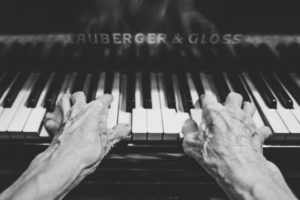
Photo by Lukas Budimaier on Unsplash
What human beings are is creative. We are sensual. We thrive on expression and ritual. We hunger for spiritual nourishment. At our best, we’re observers, recorders, problem solvers, explorers and synthesists. We’re curious. As in the old stories, we go out into the world and seek our fortunes, our mates, our place, our families, our passion, our destinies and ourselves. Yes, there are plenty of madmen/women, megalomaniacs, destroyers and other pitiless, power-hungry, dangerous, destructive people out there. Entire human cultures have disappeared, leaving behind nothing but artifacts and fragments of language. Many, many other kinds of life have vanished as well, and many more are at risk. Yes, there are people who steal real property as well as intellectual property. There are people who would gladly wipe out whole groups of humans and other life, given the power. It’s happened before and it will no doubt happen again.
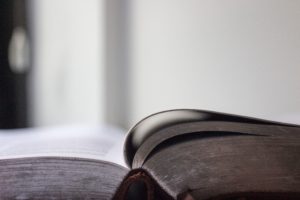
Photo by Jazmin Quaynor on Unsplash
Have you noticed, though? Life — human, animal, plant — goes on. No one can really steal our heritage or our identity, because those things reside within us. Plagiarism and duplication are sterile things. Culture persists. It might go underground for generations in order to survive, but it persists and eventually shows itself to the world again. Stories, music, traditional arts and crafts, religious rites, dance, clothing, jewelry, language and tools are all seeds of culture. When someone with cultural seeds in their pockets reaches across boundaries to another culture, powerful, life-sustaining, magnificent collaboration happens, the kind of collaboration that allows an ordinary person like me to create a multicultural dance track and lead a small group of people (all kinds of people) in dance, which is a human cultural tradition from the dawn of man/womankind. The mingling of cultures creates new cultures, as well as sustaining the original parent cultures. If one person reading this discovers new music to add to their lives and pass on, a long history of cultural tradition goes with it and is preserved. I’ve succeeded as a link in the chain going right back to the first humans.
Eric Carle has had a hand in shaping my life, along with hundreds of other authors and illustrators. His books were read to me when I was a child, and in turn I read him to other children, including my own. He’s a unique and beautiful artist. My appreciation for his work inspired my own creativity. I was also inspired by my brother, who is a gifted musician, and I dedicate ‘The Artist’ to him, out loud, every time I tell it. I take my copy of Draw Me a Star to every telling to pass around. I’ve told ‘The Artist’ dozens and dozens of times to all kinds of audiences, children as well as adults.
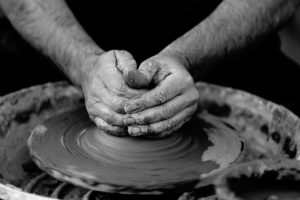
Photo by Quino Al on Unsplash
The story tells my truth. The act of creation is an act of love, appreciation and respect. Creation never happens in isolation. It’s never pure. It’s always a maelstrom of conscious and unconscious influence, memory, and inspiration from things seen, heard, read, felt and experienced. Culture is not static. It adapts, adjusts, persists, learns, discards, incorporates, borrows and contributes, or it dies.
Last week I wrote about making ourselves small. Cultural eradication makes the family of man smaller. Plagiarism kills creativity. Appropriation shrivels our souls. The threat of tribal shaming limits our joy in discovery and exploration outside our cultural boundaries. Choosing rigidity, hoarding and withholding our beautiful languages, our nourishing spiritual wisdom, our rapturous music, our skills and traditions, impoverishes us. Refusing to experience, explore and appreciate other cultures and their richness also impoverishes us. Sterility and isolation in, sterility and isolation out.
The greatest honor I can give the countless musicians, authors, artists, dancers, storytellers, photographers, sculptors, weavers, gardeners, mystics, filmmakers and other creators who grace the world is to see, to listen, to be touched, to weep, to laugh, to dance, to receive, to learn from, to be inspired by, and to add my own work to the dynamic, ever-changing culture of humanity.
All content on this site ©2017
Jennifer Rose
except where otherwise noted
by Jenny Rose | Mar 9, 2017 | A Flourishing Woman, Body, Food
This is a third post in a series in which I’ve questioned the relationship between American dietary standards and health and written about my own personal journey with diet. This week I’ll focus on some of the ideology embedded in diet and food production.
In my first post, I briefly mentioned vegan bullying. Because of the way we choose to eat, my partner and I spend some time in digital conversations about food. I’ve been amazed by the hostility and hatefulness directed towards people who choose to produce, harvest and/or eat meat.
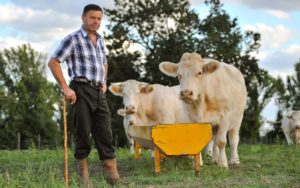
Photo by Agence Producteurs Locaux Damien Kühn on Unsplash
All people need to eat in order to live. That’s a given. I believe most individuals want to be able to feed themselves and their families with high-quality, healthy food. Sadly, because we live in a capitalist and consumer culture, this basic need is hugely impacted by financial, political, social and geographical variables. Additionally, diet is inextricably entwined in the religious and spiritual framework of many people.
Just this short list of factors make the basic necessity of putting food in our mouths complicated. Obesity and other eating disorders, as well as food-related diseases and health issues (which may be to say all diseases and health issues) reflect that.
Add to that a small but vocal group of people who take it upon themselves to judge, criticize, bully, shame and threaten others about their diet, and we’ve got a mess.
Now, there are all kinds of stated reasons why some people think they have a right to mandate what and how we all should eat. Some folks claim to be animal rights activists. Some talk about guilt, as in “What do you do about your guilt about eating the flesh of a dead animal?” Others say cows are killing the planet.
The list goes on. You get the idea.
I’m not a science teacher and this blog is not about handing out an academic education, but the cows killing the planet thing belongs under the heading of alternative facts. It simply isn’t true, and a brief survey of science-based permaculture, climate change and basic biologic history demonstrates that. Properly managed, the presence of animals is essential to healing the planet. Believe it or don’t believe it, but for me this is nonsense and I’m not interested in debating it.
The animal rights activism excuse really gets under my skin. First of all, equating eating meat with hating animals is first grade level reasoning. The world is filled with hunters who deeply respect and love the land and the animals they hunt and harvest. They show that respect by protecting the health of wildlife and wild land, doing their best to get a clean and efficient kill shot, using all of the animal they kill and supporting sustainable hunting practices. Of course, there are plenty of the other kind out there, lots of idiot trophy hunters and poachers who need a rack or a pelt in order to feel powerful. I don’t deny it. What I do say is that hunters are like everyone else — some are respectful and see themselves as part of the system we inhabit, and others operate strictly from power-over and see themselves as masters of the universe.
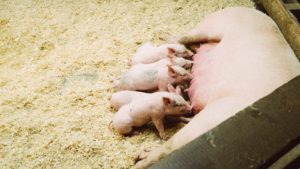
Photo by Greg Ortega on Unsplash
This also holds true for food producers. A small family farm hand raising meat with love, affection, attention, rotational grazing on healthy land and a good natural diet is a beautiful place. These people love their animals and the land. They also slaughter, butcher and eat their animals. They participate in, understand and respect every part of the cycle, from breeding to table.
To equate something like that with the nightmare of some modern mass meat production is simply ridiculous. If you want to see cruelty to animals, all you have to do is whisper “profit” into the ear of a corporation. Big Oil, the cosmetic industry and the fashion industry are just a short list of entities who have done plenty to destroy animals and habitat, and most people don’t care.
Incidentally, I’ve spent much of my life involved with animal rescue. I’m proud to say my mother is one of the most talented people I’ve ever met or heard of with animals and she’s largely given her life to making the world a better place for them, particularly horses and dogs, but by no means exclusively. This has all been volunteer work, done out of respect and love for the life in the world that can’t fight or speak for itself. She doesn’t see herself as better than. She sees herself as part of. The animals honor her with their presence and companionship, not the other way around.
So, yes, I eat meat with great enjoyment, AND yes, I love animals. I’m not limited by an inability to dwell in the sacred and powerful duality of life and death.
Bigger than all of this, however, is the guilt aspect, the real heart of this post. A vegan asks, “What do you do with your guilt about eating dead animals?”
For me, this question is much bigger than an issue of diet. The question reflects just how far we’ve strayed from wisdom, health and sanity in this culture.
When did we become amputated from our rightful place in the complex, miraculous web of life around us? What are the roots of the tragic and fatal arrogance that makes us believe we’re in control of life and death in our complex system? At what point did we become estranged from aging, loss, death and decay, which is to say HALF the full, powerful cycle of life?
Life is death. Death is life. Neither has meaning without the other. Both are essential. All life feeds on death. When we walk in the forest we’re walking on death. The whole natural world is based on prey and predator, eaten and eater. What does a tree do about its guilt as it feeds off and roots in the bodies of its companions? What does an eagle do with its guilt when it takes a salmon? What does a lion do with its guilt when it runs down a gazelle?
The guilt in that question is a projection. I don’t have any guilt about eating meat, and I think it’s tragic that anyone has guilt about the necessity to eat. If you pull up a carrot and eat it, you kill it. Every bite of food we put in our mouths is possible because of death. We exist as part of a vital, dynamic and inestimably beautiful and precious system that ebbs and flows, dances, fluctuates, cycles and revolves around life and death. We can choose to act as a unique and valuable part of that system by using only what we need, nurturing and learning from the life around us, and joyfully participating in all the ongoing life-death-life-death cycles around and within us, or we can choose to deny, destroy, and/or desperately try to control life and death, which is a completely fruitless (no pun intended) endeavor. We, thank God, are not that powerful.
The seasons will cycle. New life will be born in the midst of death. The green world will reseed itself, sprout, grow, bloom, fruit and die. The microscopic world and fungi will continue to break death into a rich placenta that sustains the next generation of life. Life is an incredible privilege. Death is part of that privilege. Nurturing life and allowing to die what must is part of what it means to me to be a woman.
I don’t know what’s going to happen to my country, the climate, or the planet. I’m afraid for us all, and the world we call home. What I do count on is the mighty cycle of life and death. All things change. All things move and flow. Nothing ever stays the same. All our fear and desperation, our greed and selfishness can’t change life and death.

Photo by Andrea Tummons on Unsplash
What I can do is figure out how to best support my body with food. Then, I can make choices about how I procure the food I eat — to some degree. I don’t have the means right now to grow my own meat. However, I can and do buy eggs from a neighbor farmer, driving very carefully into the yard so as not to run over her free-range chickens and ducks. I can take the time to relish and appreciate opening a many-times recycled egg carton and looking at a whole variety of shaped, sized and colored eggs, mixed with occasional bits of straw and feather fluff. I can save money so I can buy a half an animal in the fall from a local small farmer to put in the freezer. I can buy fresh local yogurt, butter, cream and cheese from the farmer’s market.
It seems to me our energy should be going into making sure everyone has adequate food and clean water, and that we treat our food sources, whether animal or plant, and the system within which they grow (you know, the planet? Earth?) with love, intelligence and respect. We all can do something about food. Those among us who are doing the hard and unprofitable (financially) work of growing food on small farms may well hold the keys to our future survival. What they know about permaculture, holistic environments, food forests, sustainability, breeding, planting, harvesting and slaughtering is truly the wisdom of life.
Which is to say the wisdom of death.
Which is to say, again, the wisdom of life.
Bon appetit.
See the fourth post in this series here. Check my Resources page for links to information about diet and nutrition.
All content on this site ©2017
Jennifer Rose
except where otherwise noted










